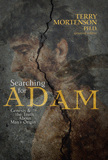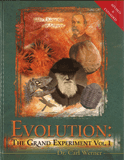
What Your Children Learn in Public Schools
How Public Schools Indoctrinate in Evolution
What will your children be taught in public school this fall? The research is abundant and unequivocally clear. Instead of educating, many public schools now indoctrinate with the secular humanist worldview and against the Christian worldview. The indoctrination is often subtle and, therefore, usually more effective. Increasingly, due to the enormous growth of secularism in the past decade and the antagonism of powerful secular organizations such as the powerful ACLU and the teachers’ unions, school textbooks are becoming less subtle, openly pushing Darwinian atheism and condemning any alternative view.
One example is a popular textbook by Stephen Law, titled Really, Really Big Questions About Life, the Universe, and Everything, which begins by asking the student, “Have you ever wondered: Where did everything come from? Did someone design the universe?” Then Law explained the question in more detail:
“We inhabit a vast universe. Our planet, Earth, revolves around the Sun, which is just one of the many billions of stars that make up our galaxy, the Milky Way. And there are many billions of such galaxies. Where did all this come from? Why is it here? Was it designed by God? And how did living things appear? Why is there something rather than nothing?”1
The author then answers his own question:
Scientists say that the universe started with an enormous explosion—called the big bang—in which all matter and energy, and even time and space, began. This happened about 13 billion years ago.2
It is difficult to keep up with the ever-changing date estimates of the cosmos, but the evolutionary community teaches that the universe is, according to evolutionists, rapidly getting older. In the 1800s, “science” thought it was millions of years old. When astronomer Edwin Hubble plotted the redshift expansion line for galaxies in 1929, the estimated age of the universe was about 2 billion years. My science textbook published in the late 1950s gave the figure 2 billion years for the age of the earth. Now the estimate is closer to 4.6 billion years old. In the 1970s, the oldest stars were believed to be at least 10 billion years old. Needless to say, I take these exponentially increasing numbers with a grain of salt. Law continued:
What was before the Big Bang? the big bang . . . has an after . . ., But there is no before. The big bang marks the beginning of time itself . . . nothing happened before the big bang because there was no time for it to happen in. So there was no time or space or matter or energy or anything at all. [then] Pop—the universe appears [out of nowhere]!3
Matter popping into existence is a violation of the first law of thermodynamics which says matter can neither be created nor destroyed by natural processes.
Matter popping into existence is a violation of the first law of thermodynamics which says matter can neither be created nor destroyed by natural processes. This is a fundamental law of physics known as the law of conservation of mass/energy. To support evolution, Darwinists must resort to the anti-science answer of things popping into existence as if by magic. Next, Dr. Law explained the creation viewpoint:
Some people believe that not only do eyes, and living things generally, have a designer, but so too does the whole universe and everything it contains. They think that planet Earth was carefully designed for us to inhabit—there’s just the right kind of food, just the right amount of water, and there is oxygen in the air. How likely is it that the world should fit us so perfectly, just by chance who designed the world for us.4
This was the explanation believed in Western society until 1859 when Charles Darwin unleashed his theory of evolution to the world. Now the majority of academics and scientists have rejected it. Law cited a story by Douglas Adams to refute the creation explanation: “Imagine water in a puddle thinking this hole I am in fits me perfectly, so well that it must have been made just for me!” Law then comments, “If the hole wasn’t designed to fit the puddle, why suppose Earth was designed to fit us?”
The answer is that the earth was specially designed to support human life. We now know of over 5,000 planets in the universe, and more are being discovered all the time. None of them are even close to being able to support life.5 Thousands of specific conditions are required for life to exist. The planet must be the right size, it must have a sun and moon that is the right size and distance from the earth. It must have a magnetic field of the right strength and an atmosphere consisting of an ozone layer, troposphere, stratosphere, mesosphere, thermosphere, and exosphere.6 Many excellent secular books document the fact that the earth was created for humans and no other planet is even close.
Earth must also have plate tectonics, volcanoes, and oceanic and continental crusts. “Oceanic crust is denser and thinner and mainly composed of basalt. Continental crust is less dense, thicker, and mainly composed of granite.”7 The mantle lies below the crust and is up to 2,900 km (1,800 miles) thick. The core of the earth is made almost entirely of metals—iron and nickel. “Elements that dissolve in iron, called siderophiles, are also found in the core.”8 The core is designed to produce a magnetic field. The earth’s magnetic field is, as far as is known, generated in the fluid outer core by a dynamo process.9
Electrical currents flowing in the slowly moving molten iron generate the magnetic field.10 Without the magnetic field around the earth, life could not exist on it because solar radiation/solar winds would rapidly strip away our atmosphere and allow the sun to irradiate all life. The magnetosphere, together with earth’s atmosphere, protects our planet from cosmic rays and charged solar particles.11 “The magnetosphere is formed by the interaction of the solar wind with earth’s magnetic field.”12 Yet claims, such as those of Dr. Law, still lead so many well-educated, young people to reject Christianity and often God as well.
To illustrate the diversity of life, Dr. Stephen Law, in his popular textbook Really, Really Big Questions, states:
In our forests, jungles, deserts, and oceans, there is an extraordinary range of living things—from enormous blue whales to tiny jewel like insects. But where did all of these different species come from?13
Then Law lists one possibility that explains where all life came from:
Take the Bible. It says the world was made in six days. On the third day, God made all of the plants: on the fifth, creatures of the sea and sky: and on the sixth day, he made the land creatures. These stories from different times and places, and religions are . . . wonderful. But are they true?14
On the next page, the author argues that the Bible account is wrong. The truth, he dogmatically claims, is evolution. Under the heading, “What Is Evolution,” Dr. Law then explains how evolution works:
Today almost all scientists agree about how life appeared on Earth. They say the different species emerged very slowly, over many millions of years by a process called evolution. At first there were only simple life-forms on our planet. As these simple things reproduced they sometimes changed slightly, gradually over enormous periods of time these small changes added up to bigger changes, until new more complex kinds of creatures began to emerge.15
He then adds the following:
Charles Darwin discovered the process of natural selection, which provides one explanation for why species evolve. When living things reproduce, their offspring may be slightly different. Changes suited to a particular habitat are more likely to be passed on to the next generation than those that are not. So living things gradually adapt to fit their surroundings.16
The fact is that humans have been breeding animals for thousands of years and always reach an end point where additional change is not possible. Much variety exists in the animal world, and some animals are easily capable of change; hence, they are greatly adaptable. This includes dogs, cats, and horses. Even with these animals, however, genetic limits exist. Breeders were once able to breed faster horses but now have reached the equine limit. From 1875 to 1950, Kentucky Derby winners’ average thoroughbred speed increased by roughly 10 percent. Since the 1950s, though, the average speed for winners has been very similar. The horse speed limit has been reached. In most animals, such as skunks and raccoons, very little genetic variety exists. If limits have been reached by breeding experts (as intelligent designers) that they cannot go beyond no matter what they do, how can one believe that better results can be achieved by mutations and chance in the wild?
Evolution teaches the progression from molecules to cells, to bacteria-like life-forms, to amphibians, reptiles, mammals, primates, and, lastly, to humans purely by the accumulation of mutations that are relied on to produce genetic variety. Evolution claims that the genetic variability provided by mutations is then culled and preserved by “natural selection,” a process called “survival of the fittest.”
The major problem with this idea is that close to 99 percent of all mutations are near-neutral, deleterious (very harmful), or lethal. Near-neutral means they only cause slight damage, but the slight damage adds up in time, causing genetic catastrophe, i.e., death and, eventually, species extinction.
The genetic burden (i.e., mutation load) in humans is gradually accumulating, eventually leading to mutational meltdown and extinction. Health care professionals are very aware of this fact, and one of the main focuses today is to medically counteract the damage caused by mutations. Mutational events also are the cause of aging—thus entire species age, as do all life-forms. Species aging eventually causes species extinction.
Despite this reality, most leading scientists favor the view that mutations are our creator, not God.
Despite this reality, most leading scientists favor the view that mutations are our creator, not God. This view is not only irresponsible: it is contrary to fact. This view is believed partly because the lower courts have, without exception, ruled that evolution must be taught in all public schools as fact. Furthermore, information contrary to this worldview must not be taught in public schools because the courts have ruled that doing so is teaching unconstitutional “backdoor religion.”
The big bang teaches that the entire universe came from an extremely compact something called “the primordial egg.” This view, held by leading scientists such as Stephen Hawking, teaches that, for some unknown and unexplainable reason, this primordial egg “exploded.” From this explosion, matter, energy, time, and space were all created. In short, the “scientific” view is literally that nothing created everything. Thus, from nothing came everything. Evolution tells us not only where we came from but also where we are going. You are born, live, and die, and that is the end of your life and of all life. No heaven and no hell. Eventually, the stars will also burn out, destroying the planets and their moons. The universe will then consist of dust spread out to the level that the cosmos will forever consist of a state very close to a vacuum. Never again will life, or anything else, exist anywhere. In short, evolution is not only scientifically false but is a pessimistic, depressing worldview devoid of hope and a future.
Creation, conversely, tells us a very different story. It is an account of purpose, meaning, and life eternal with a God who, in the beginning, created everything from nothing and cares about us. In my church and school presentations, using both verbal and pictorial illustrations, I document and explain this in more detail. The evidence for a Creator God is found everywhere in both the physical and biological worlds. According to his written Word, God will not allow the ultimate, pessimistic state of affairs envisioned by secular atheistic scientists to occur. Hallelujah!
Additional References
Guillermo Gonzalez and Jay W. Richards, The Privileged Planet (Washington, D.C.: Regnery, 2004).
Peter D. Ward and Donald Brownlee, Rare Earth: Why Complex Life Is Uncommon in the Universe (New York: Springer Verlag, 2000).
Footnotes
- Stephen Law, Really, Really Big Questions About Life, the Universe, and Everything (London: Kingfisher Publications, 2009), 9.
- Law, Really, Really Big Questions.
- Law, Really, Really Big Questions.
- Law, Really, Really Big Questions.
- Peter D. Ward and Donald Brownlee, Rare Earth: Why Complex Life Is Uncommon in the Universe (New York: Springer Verlag, 2000).
- Guillermo Gonzalez and Jay W. Richards, The Privileged Planet (Washington, D.C.: Regnery, 2004).
- Geological Survey, “The Earth’s Structure,” Our Planet Earth, Education, accessed August 1, 2024, https://www.gsi.ie/en-ie/education/our-planet-earth/Pages/The-Earth-structure.aspx#:~:text=This%20is%20the%20outside%20layer,and%20mainly%20composed%20of%20granite.
- National Geographic, “Core,” accessed August 1, 2024, https://education.nationalgeographic.org/resource/core/.
- British Geological Survey, “The Earth’s Magnetic Field: An Overview,” Overview of Geomagnetism, accessed August 1, 2024, https://geomag.bgs.ac.uk/education/earthmag.html#:~:text=The%20Earth's%20magnetic%20field%20is,iron%20generate%20the%20magnetic%20field.
- British Geological Survey, “The Earth’s Magnetic Field.”
- NASA Science Editorial Team, “Earth’s Magnetosphere: Protecting Our Planet from Harmful Space Energy,” NASA, August 3, 2021, https://science.nasa.gov/science-research/earth-science/earths-magnetosphere-protecting-our-planet-from-harmful-space-energy/.
- NOAA, “Earth’s Magnetosphere,” Space Weather Prediction Center, accessed August 1, 2024, https://www.swpc.noaa.gov/phenomena/earths-magnetosphere#:~:text=The%20magnetosphere%20is%20the%20region,wind%20with%20Earth's%20magnetic%20field.
- Law, Really, Really Big Questions.
- Law, Really, Really Big Questions.
- Law, Really, Really Big Questions.
- Law, Really, Really Big Questions.
Recommended Resources

Answers in Genesis is an apologetics ministry, dedicated to helping Christians defend their faith and proclaim the good news of Jesus Christ.
- Customer Service 800.778.3390
- Available Monday–Friday | 9 AM–5 PM ET
- © 2026 Answers in Genesis



![Is the Purpose of Public Education “To Teach [Children] What Society Needs Them to Know”?](https://assets.answersingenesis.org/img/cms/content/contentnode/image/public-school.jpg)



